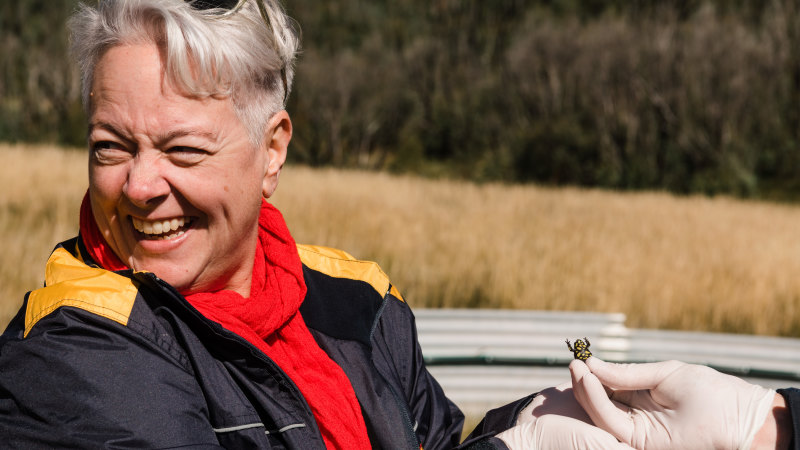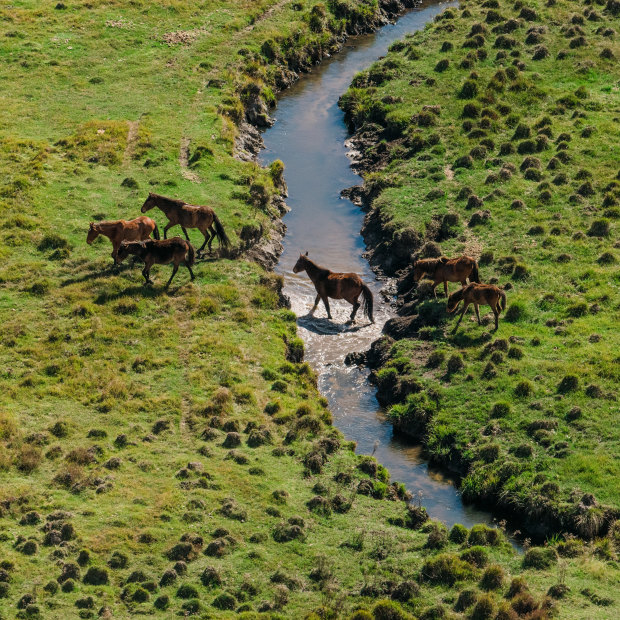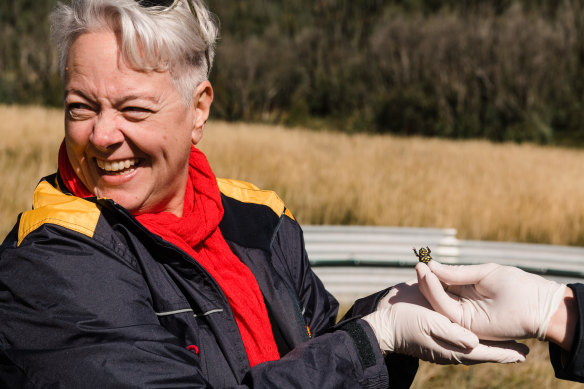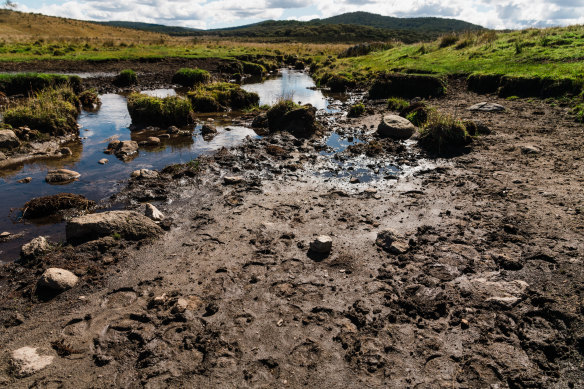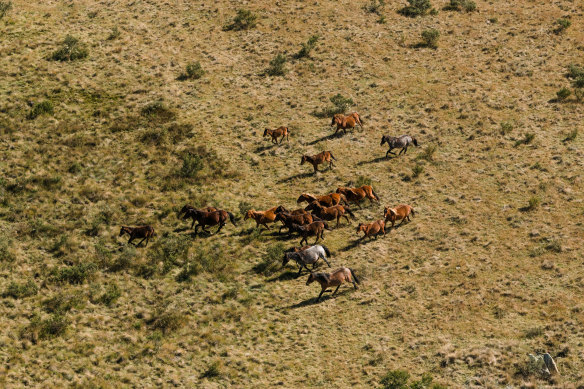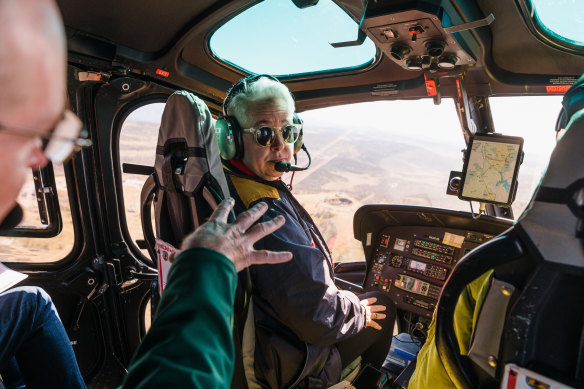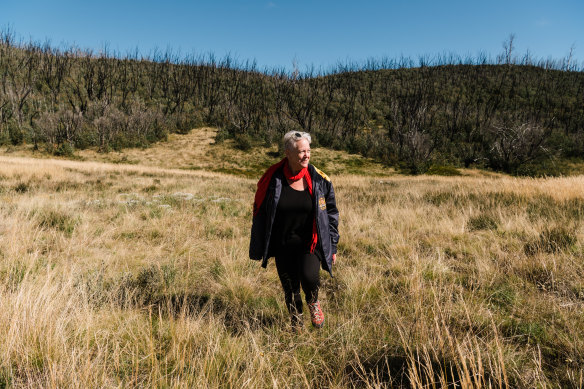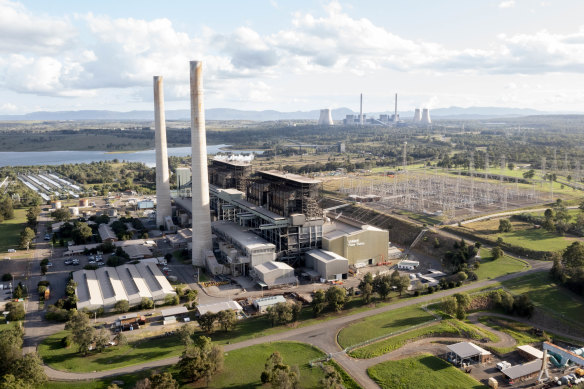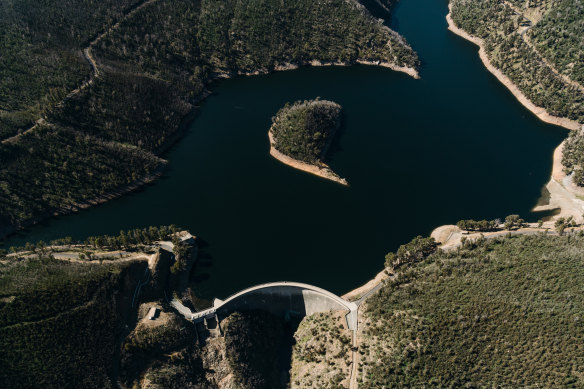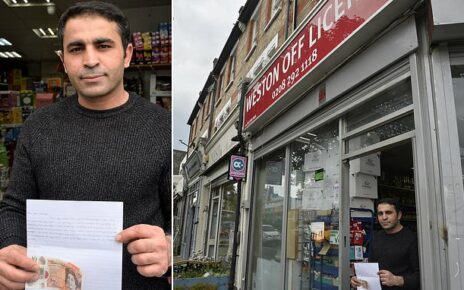By Laura Chung and James Brickwood
One of the many issues NSW Environment Minister Penny Sharpe will face is how to deal with the growing number of feral horses.Credit:James Brickwood
Save articles for later
Add articles to your saved list and come back to them any time.
Penny Sharpe holds a small, black and yellow Corroboree frog in gloved hands, protecting it from the freezing winds. The amphibian, which is highly toxic, calmly explores its surroundings, completely unaware that the woman who holds it is responsible for helping to bring its numbers back from the brink.
The frog is critically endangered, with only 300 of the southern species of frogs remaining in the Kosciuszko National Park (there are up to 1000 of the northern species left). But ensuing the frog’s survival is among many of the challenges Sharpe will face after stepping into the role of environment minister last month following Labor’s state election win.
Southern Corroboree frogs numbers have plummeted following disease and bushfires, representing some of the massive challenges Sharpe will face while in office.Credit:James Brickwood
Sharpe is no stranger to politics. She became a member of the legislative council in 2005 and has held many roles in the Labor Party since, including deputy leader in 2018. She previously served as the parliamentary secretary for transport, parliamentary secretary for mining and energy, and more recently as shadow minister for the environment.
But Sharpe has now stepped into the biggest role of her life, inheriting four of the biggest portfolios in the state: climate change, energy, environment and heritage. Despite the challenge, Sharpe said the issues were interlinked, and the biggest challenge would be addressing the state’s biodiversity crisis and climate change while also ensuring the smooth transition to renewables. After several years of putting pressure on the opposition to act on various issues, she’s finally got her chance.
“I’m feeling excited about really being able to do something rather than just talk about it,” Sharpe said. “I’m not naive to the challenges either. It’s a big responsibility that comes with the trust that we’ve been given [by the people of NSW].”
As Sharpe settles into the multiple portfolios, she is meeting with a long list of relevant people. That included a meeting with former Coalition environment minister James Griffin and energy minister Matt Kean. While Sharpe won’t disclose what they discussed, she said it showed the handover had been gracious. “There has been a generosity in the change of government,” she said.
Sharpe took one of her first out-of-office trips last week, when she toured the Kosciuszko National Park to see the Corroboree frogs, meet the people behind the mammoth effort to save them, and see the damage that feral horses are inflicting across the landscape. The Herald tagged along.
Environment
Our helicopter flew over an apparently pristine Alpine landscape with winding streams snaking across it. But on the ground, it was a different story. What first appeared to be a dirt walking track had been cleared by hundreds of feral horses, and the stream banks destroyed by their hooves.
It is perhaps one of the most controversial environmental issues the previous government dealt with. Feral horse populations in the park have increased by more than 30 per cent in two years, despite the state government setting reduction targets, prompting experts to demand a bigger culling effort.
Feral horse populations have damaged large parts of the park, including destroying river banks.Credit:James Brickwood
The current plan, which was signed off last year, is in part a reprise of the 2016 draft management document that also called for the reduction of horse numbers to fewer than 3000 horses in five to 10 years.
Many conservation groups said the increasing numbers highlighted the need to re-introduce aerial shooting of the pests. Sharpe said that’s not in the plan, which says existing measures, such as trapping, rehoming and ground shooting are enough to hit the target. Less than two years ago, Sharpe, then shadow environment minister, said the plan was a good start, but we are yet to learn what more she thinks needs to be done.
Advocacy Manager at the Invasive Species Council Jack Gough said Sharpe had tough choices to make, especially if she is to reach that 3,000 feral horse target this term.
The most recent government data indicates there are about 18,000 feral horses in the national park – a number that has been rapidly increasing.Credit:James Brickwood
“The issue of feral horses trashing and trampling the Snowies is emblematic of the broader environmental challenges facing Sharpe,” he said. “The election has given her a clear mandate to rapidly reduce the population and save our native wildlife, but years of inaction and delay under the previous government means it is not going to be easy.”
He added that the agency was pleased Labor had promised 100 new national park officers, as well as announced it would take steps to stop the sale of weeds in nurseries and establish a Biosecurity Commission. But Gough said more funding was needed to meet the ongoing invasive species threat that endangers 70 per cent of threatened wildlife and ecosystems in the state.
The number of NSW species at risk of extinction now sits at 1043, with an additional 18 threatened species added in the past three years, the latest State of Environment report indicates. A further 116 ecological communities, a group of naturally occurring plants or animals living in a unique location, are also listed as threatened.
Prior to the election, Labor’s environmental commitments were scant. It did, however, pledge funding for a Great Koala National Park, the third time it took the proposal to the election. The park, stretching from Kempsey to Coffs Harbour, could see an area of about 300,000 hectares of key habitat for the native species protected. The government has not put a figure on the potential cost of compensation for the logging industry as a result of the transfer of state forest land.
Sharpe said the proposal was vital to ensuring koalas survived in the wild, but she ruled out any sudden suspension of native forest logging. Any decision would be made carefully and consider the impact on different parts of the community, she said.
Sharpe’s trip to Kosciuszko National Park was the first time she’d been in a helicopter.Credit:James Brickwood
Whatever her decision, environmental groups will be watching closely.
Among them will be Jacqui Mumford, chief executive officer of the NSW Nature Conservation Council. Sharpe must tackle climate change by ramping up renewables, she said, as well as halting the destruction of forests, mismanagement of the Murray Darling Basin, and accounting for how fire operates in the Australian landscape.
Mumford said the government’s commitment to the Great Koala National Park was encouraging, but concerns remained around ongoing logging within the area. “We want to see a moratorium on logging across the proposed area until the assessment is complete,” Mumford said.
Energy and climate
Sharpe has set herself three goals when it comes to tackling climate change. First, she wants to legislate emission reduction targets and, second, establish a net-zero commission. The commission will develop the government’s plan to get to net-zero emissions by 2050. It will monitor and review the plan and its trajectory, including impacts on jobs and industry, as well as energy prices. Lastly, she wants to establish an energy security corporation, a publicly owned company that will accelerate renewable energy production.
NSW Environment Minister Penny Sharpe visits Kosciuszko National Park less than a month after taking over the role.Credit:James Brickwood
Future energy generation is another major issue facing the state. Attention is being sharply drawn to it with the closure of the Liddel coal-fired power station later this month and other closures drawing nearer. While Liddell’s shutdown won’t result in a shortfall in energy generation, the government remains concerned about supply further down the track. For example, Origin Energy has indicated it would like to close the Eraring coal-fired power station as early as 2025.
But Sharpe said the government would intervene to keep the station going if needed. Her job is clear: keeping the lights on, she said.
“We are not ruling out anything,” Sharpe said. “My job is to keep the lights on and to make that transition as quickly as possible. None of us want the coal-fired power plant being open longer than it needs to be, but we’ve also got a responsibility to make sure that households and businesses can go about their business.”
Part of that will also be ensuring that there are ample renewables to bolster the fossil-fuel energy that’s being phased out. Despite being in the role for less than a month, Sharpe said she was taking briefings and meetings to understand if the state’s plans were big enough, and what barriers were standing in the way.
“There has been some careful planning,” she said. “The challenge is really in the system risks in terms of supply chains, in terms of skilled workforce. We have to bring all that to bear as we make sure we not just stick to the road map, but try to accelerate it.
“I am not naive to the task, but I am very committed we do that.”
The Liddell Power Station in the NSW Hunter Valley opened in 1971 and at one point was the most powerful generating station in Australia.Credit:Janie Barrett
Clean Energy Council chief executive Kane Thornton said the new government should have several policy priorities. These include considering offshore wind farms to bolster onshore projects, streamlining planning approvals, reducing investment costs for utility-scale storage and creating incentives for residential rooftop solar and battery uptake.
He added that urgent reform was needed to accelerate transmission development and outline a plan to increase the electrification of homes and businesses.
“Over the past decade, NSW has made great progress in its transition to clean energy,” Thornton said. “In that time, renewable energy has boomed from less than 10 per cent of electricity generation to now more than 25 per cent.
“This shift has been powered by dozens of large-scale wind and solar farms as well as more than 800,000 households and small businesses with rooftop solar, totalling more than 13GW of generation capacity.
As the state prepares to phase out coal, renewable energy projects, including Snowy 2.0, are more important than ever to ensure the lights stay on.Credit:James Brickwood
“This has already created more than 7000 direct jobs and attracted billions of dollars in investment, especially into regional NSW, and has played a key role in preparing for the approaching retirement of coal power stations.”
Sharpe’s to-do list is extensive as she tackles some of the biggest issues facing the state and Australia. Back in the Kosciuszko National Park, the small Corroboree frog, like the people of NSW, will have to trust that the woman who holds it knows what she’s doing. After all, there are only 300 of its species remaining and time is running out.
Get to the heart of what’s happening with climate change and the environment. Our fortnightly Environment newsletter brings you the news, the issues and the solutions. Sign up here.
Most Viewed in Environment
Source: Read Full Article
